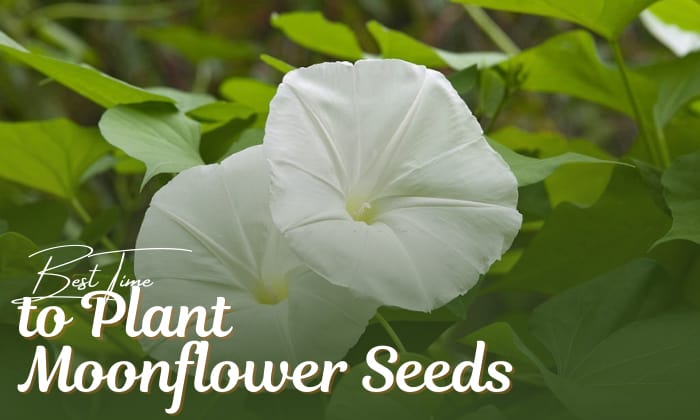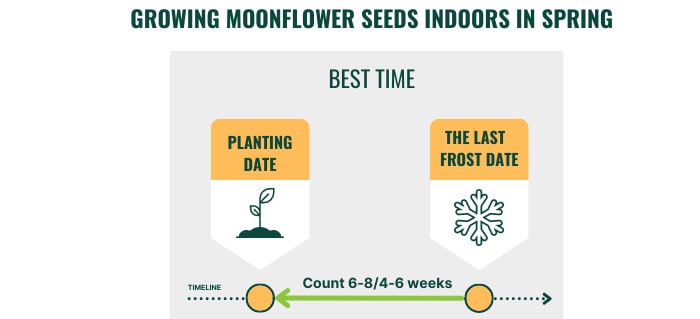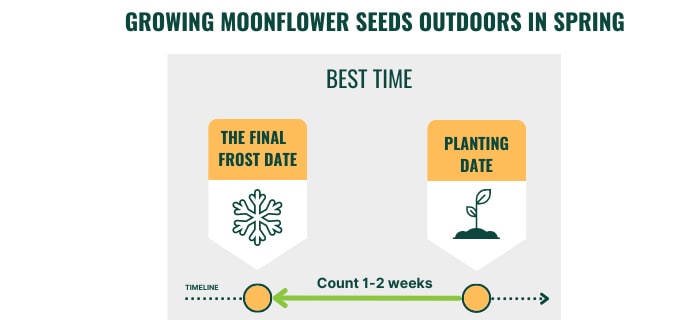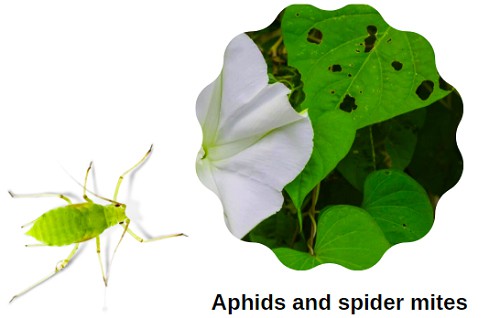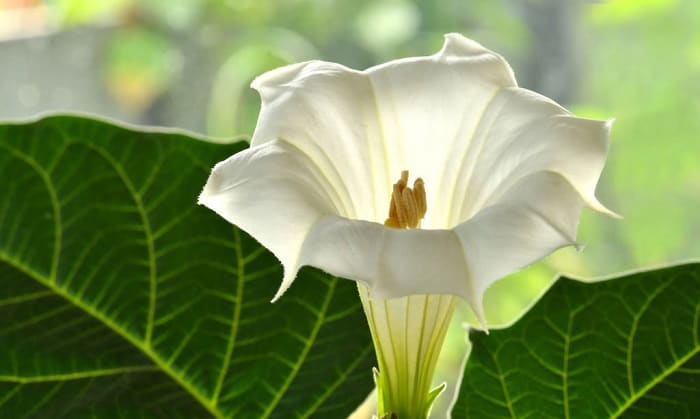Tired of flowers that bloom in the morning when you’re not home to witness it? If you feel this way, perhaps it’s time to grow some moonflowers, or Ipomoea alba, as botanists would call them. These plants blossom in the evening and produce an alluring fragrance that is guaranteed to make your garden more attractive.
You only have to know when to plant moonflower seeds to enjoy their presence. In short, it’s best to start a moonflower garden around late February to May under frost-free weather.
| Plant name | Moonflower/white moon flower/night-blooming morning glory |
| Categorization | A tropical plant under the Ipomoea genus and Convolvulaceae family |
| Appearance | Three-lobed leaves with round white or pink flowers |
| Companion plants | Cypress vines, Cardinal climber, star jasmine, gardenias, roses, and dahlias |
| Growth requirements | An inch of water a week, full sun, and a temperature of 60 to 70℉ |
Table of Contents
Best Time to Plant Moonflower Seeds
1. Plant in spring
Spring is the best time of year to plant moonflowers because they need warm weather to thrive.
In general, you have two options when it comes to growing this plant: seed it indoors or direct-sow it outside. Considering that moonflower roots are sensitive to disturbance, it makes more sense to seed them in the garden and avoid transplanting.
However, I recommend sowing moonflowers indoors if you have a shorter growing season and live in a cold area. Just make sure to use a biodegradable pot to minimize root disturbance.
Here are the timeframes for starting a moonflower plant:
- Indoors – six to eight weeks or four to six weeks before the last frost
- Outdoors – one or two weeks after the final frost
As your plants grow, flower, and produce seeds, allow moonflower pods to dry on the vines in the fall and their seeds to drop to the ground. You can keep the soil damp and wait until spring comes, at which point the temperature will be warm enough to facilitate germination.
Another option is to harvest moonflower seeds, dry them at room temperature for three to five days, then keep the seeds in an airtight container until it’s time to plant them in spring.
Whatever you choose to do, the time to gather seed pods or let moonflower self-seed is around October. Moonflowers will die in winter within hardiness zone 9 or lower. Here, it is best to remove them to make space for next season’s planting. For zone 10 to 12, cut your moonflowers and mulch the ground so that they’ll survive winter.
2. Planting time for different states
Here is the estimated time to plant moonflower vine seeds for some US states.
Regions-wise, the best place for growing them is the south or hardiness zone 9 to 12. You can start moonflower seeds in zone 3 or 4, but only in the summer when temperatures are high.
| State | Indoor planting | Outdoor planting |
| Florida | February | Mid-April |
| North Carolina | January to March | March to May |
| Arizona | November to May | January to June |
| Texas | November to March | January to April |
| California | November to March | Late January to May |
How to Plant Moonflower Seeds?
Plant moonflower seeds in soil with a pH of 6 to 7.5, somewhere with at least six hours of full sun per day.
In spring, sow the seeds at a depth of ¼ inch under a temperature of 60 to 70℉. You can space them six inches apart, since that’s how wide they can get, or position the plants twelve inches from one another to forgo thinning them down once they’re one or two inches tall.
The planting depth for growing moonflowers in containers is the same as for in-ground planting, but instead of garden soil, you should use a seed starting mix. I also recommend opting for peat pots to minimize transplant shock, since they will biodegrade over time.
Place the pots under bright, indirect light, and lay them on top of a heating mat if the weather is cold. Harden off the moonflower in pots for seven days before transplanting it outdoors.
Whether you have containers or in-ground gardens, keep the soil moist with an inch of water per week.
Some Common Problems With Moonflowers
Here are some problems you may encounter when growing moonflower from seed, plus ways to handle them:
- Black rot
To prevent black rot, water the soil, not the foliage. Give the plants adequate space to spread and remove weeds to minimize possibilities of infection.
- Aphids and spider mites
These insects can suck on and destroy moon flowers’ foliage. The easiest way to deal with them is by spraying an insecticidal soap.
- Damping off
The same methods to prevent black rot will work here. Do not place moonflowers too close together. Avoid overwatering as well, since overly humid environments encourage fungal growth.
Too much nitrogen fertilizer should also be off-limit, as it not only causes damping off but also hinders flowering. If you see your moonflower not blooming, overfeeding may be the cause.
Tips for Taking Care of Moonflowers
After following the planting instructions above, fertilize moonflowers every three to four weeks if they suffer from nutritional deficiencies. Before doing so, check your soil and see whether it lacks phosphorus, since this mineral helps with blossoming.
Trellising the plant is also vital moon flower care, and the earlier you do it, the better. Put a trellis near the plants so that they have something to climb on. Make sure the structure is at least six feet tall, or up to 20 feet in height if you can find a support frame that big.
Install the trellis before vines start to show up, or, if we take into account moonflower growth stages, before the first month is out.
If you’re curious about the plant’s development, it should look something like this: germination or seedling (7 to 14 days), vine and bud stages (one to two months), flowering (happens after vining but may take up to six months).
Frequently Asked Questions
What are the different types of moonflower?
Aside from the Ipomoea alba plant we discussed here, there exist other plants with the same common name of “moonflower.”
- Examples include Ipomoea leptophylla (bush moonflower), Ipomoea violacea (sea moonflower), or Ipomoea turbinata (purple moon flower).
- You might have also heard of Datura plants, which belong to a different genus (Datura instead of Ipomoea) that people also refer to as moonflowers.
This brings us to our next question: “How do you know which cultivar you’re growing, and is moon flower poisonous?”
If you’re unsure which plant you have, remember that we can recognize Datura by their spiky moonflower seed pods, as well as the fact that they bloom during the day and not at night.
These plants are also much more dangerous than Ipomoea, though both can be toxins and hallucinogen if eaten. A moon lily flower or Datura is more likely to kill someone if ingested, so it’s best to avoid growing it, especially if your family has young children.
Moonflower bush seeds or vine seeds, however, are much less risky to plant.
Are moon flowers illegal?
Some are. Check the state law where you live and see if your chosen cultivar is considered a noxious weed. Thurber’s morning glory (Ipomoea thurberi) and three-lobed morning glory (Ipomoea triloba), for example, are illegal in Arizona, meaning people cannot sell them.
Do moon flowers come back every year?
You can expect blooming moon flower vines every year if you live in hardiness zone 10 to 12. In cooler areas, this plant will function as an annual.
Do you soak moonflower seeds before planting?
Yes. Overnight soaking will accelerate sprouting. You may see germinating moonflower seeds within two weeks if you soak them beforehand. Nicking them with a knife will further accelerate this timeline, reducing sprouting time to four days in ideal cases.
How long does it take for moonflowers to bloom from seed?
It will take a month or two if conditions are optimal. Otherwise, moonflowers may require up to six months to bloom.
Conclusion
Determining when to plant moonflower seeds is straightforward—simply look up your spring frost date and count backward or forwards according to our tips above. If you have not grown moonflowers yet, now is the time to reconsider.
These plants will add a romantic touch to your dinners or parties, whether you intend to have guests over or celebrate a special occasion with only your loved ones.
Standard planting schedule for other flowers:

Hi, I am William – Floridayards’ digital content creator. My job is to find answers to all your concerns with thorough research and our team’s expert advice. I will also bring you honest reviews on the best products and equipment for raising your beautiful garden. Please look forward to our work!


